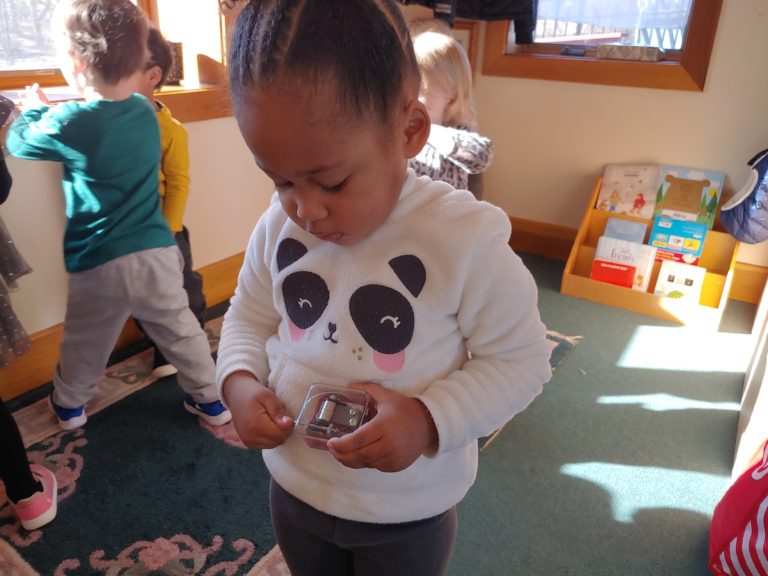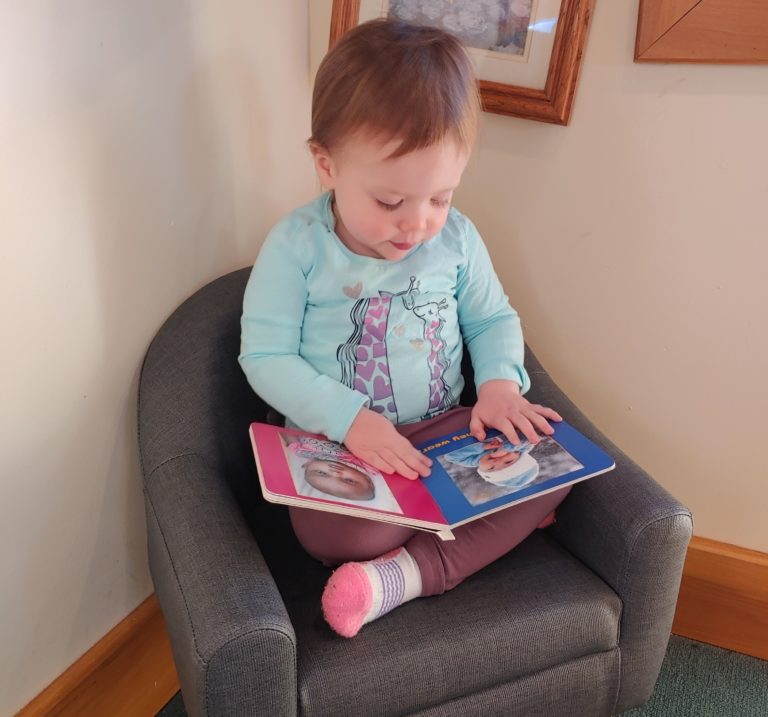
During the first three years of life, the child is engaged in the conscious acquisition of language, which includes building concepts and understanding the organization of sounds, words, and structure through concrete experiences. This means we are always aiming to fill our classroom space with real, meaningful, and rich language experiences.
Language and Vocabulary
In the toddler environment, the adults are ‘language materials’ in the sense of providing and modeling spoken language. The first group of activities in the language area is meant to develop and enrich language with a variety of exercises that represent a progression from concrete to abstraction. Structured Montessori Two Period Lessons are our way of introducing new language and vocabulary to the children. These lessons are meant to be interactive and fun and offer the children a means to explore and understand the new words and concepts being shared with them. Language materials are always presented as categorized sets. This helps the children start to organize and classify the information that we are presenting to them. Children often engage in these activities as a small group with an adult and they are a favorite choice!
These activities are also designed to introduce the children to the spoken language and guide them through increasing levels of abstraction starting with real objects. After real objects, we use replicas and objects with exact matching cards. With each different type of language activity, we are guiding the child to a deeper understanding of the world around them through levels of abstraction. In this exact activity, the children come to understand that something that is in two dimensions can exist in three dimensions. Following are objects with similar matching cards. The purpose of this material is for the children to generalize. They are building concepts and ideas about the words that we are presenting to them. Here they are encouraged to see similarities, differences, and what are the foundational characteristics involved when using an exact vocabulary word. Finally, there are Nomenclature Cards. These are the most abstract for toddlers. These are language cards with a single image on them.
Art and Self-Expression
The activities in the Art and Self-expression group are designed to present the child with yet another means of communication. They are also meant to support the child’s development of logical and sequential thinking, abstraction, and fine motor coordination.


The Art and Self-expression activities, such as clay and molding tools, emphasize the process, techniques, and different skills used to master different mediums. The possibilities for meaningful extensions are almost endless. Through these Art and Self-expression activities, we give children the tools and the skills necessary for them to express themselves in a different way. Our Mantra for Art and Self-expression activities is, “It’s the process, not the product.”
Music and Movement
The activities in the Music and Movement area are designed to present the child with another means of self-expression and communication while supporting the recognition of language patterns and gross motor coordination.

Children are innately musical and love to find rhythms and move their bodies. The Montessori music curriculum also encourages children to seek out, be curious about, and understand how musical instruments work and how to use them accurately and efficiently as a means of communication and enjoyment.
Reading
In our environment, children are exposed to a variety of language activities not only through spoken language, but also songs, poetry, rhythm language, and books. We choose books with an eye for the story quality and the quality of the illustrations.

They should be true to life, interesting, and relate to everyday experiences, plants, or animals. These language activities happen throughout the day, especially during circle time and transitions.
About language development, Dr. Maria Montessori said: “Man does not ‘speak a language’ merely because he grows, as a puppy barks wherever in the world it is found, even if isolated from other dogs. Language is developed gradually, precisely during that epoch of inertia and unconsciousness of early infancy.”
